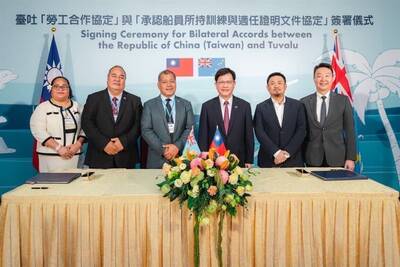The commercialization of outer space has long been dominated by the world’s superpowers, but Taiwan is hoping to carve out its own “blue ocean” in the space economy through the development of cube satellites.
Cubesats are miniaturized satellites made up of multiple cubic modules of about 10cm3 weighing 1.3kg, which can have a wide range of applications and are increasingly relevant to the aerospace industry.
In the short term, Taiwan sees cubesats as testing grounds for suppliers eager to crack the aerospace market, but the longer-term vision is to emerge as a full-service provider and use the know-how from cubesats to develop communication satellites for 5G networks.
“Cubesats provide unique opportunities for Taiwan, as they allow entities with less experience to sharpen their skills and test the feasibility of space technologies at an early stage,” said Lin Chun-liang (林俊良), who last year retired as director-general of the National Space Organization, which started the cubesat project in 2017.
The stakes could not be higher. The space economy was worth US$385 billion last year, according to Euroconsult’s Space Economy Report 2020, including US$293 billion in satellite services and US$4 billion in manufacturing — areas of particular interest to Taiwan.
A major milestone in Taiwan’s cubesat journey came last month when the first two Taiwan-made cubesats were launched into space on a SpaceX rocket on Jan. 24.
One of them was the Ionospheric Dynamics Explorer and Attitude Subsystem Satellite, dubbed “Flying Squirrel,” which was developed by National Central University (NCU). The satellite is to be used to research how plasma in the ionosphere affects radio waves used in 5G communications.
The other was YuSat, named after the Taiwan’s highest mountain, Yushan (玉山), which was made by New Taipei City-based MoGaMe Mobile Entertainment and is primarily to be used to monitor marine traffic.
Flying Squirrel weighs 4.5kg and cost NT$40 million (US$1.41 million), said Chao Chi-kuang (趙吉光), director of NCU’s Graduate Institute of Space Science and Engineering, and an adviser to the government on cubesats.
In contrast, Formosat-5, which was launched in 2017, weighed 450kg and cost NT$5.6 billion, a difference that highlights the value of cubesats.
“Miniaturization is crucial in commercial applications, as it substantially lowers costs and entry thresholds for interested parties, including universities and individuals,” Chao said.
However, proof-of-concept opportunities might be the biggest commercial niche cubesat development can fill, he said.
This means that the satellites can be used to test an idea or method, a critical step in the research and development of space technology, offering cheaper testing in an industry that regularly handles billions of New Taiwan dollars.
Cubesats typically use off-the-shelf components that are designed for consumer electronics, such as laptops and smartphones, rather than specifically developed space technology, and give local electronics companies a chance to see how their products stack up, Chao said.
“To build a sustainable aerospace industry in Taiwan, companies must prove that their electronic components or systems work in space — and we will have to test the technology ourselves, instead of relying on other countries to do it for us,” he said, adding that components certified space-ready in Taiwan could be exported.
Taiwan is also eyeing the development of its own communications satellites, hoping to benefit from the hands-on experience of making cubesats.
Lin said that the government would prioritize the development of low-orbit satellite constellations to support 5G and faster networks, and try to export the technology to meet the growing bandwidth requirements of new technologies.
To achieve these goals, the government established a four-year, NT$4 billion project with the aim of launching its first communications satellite in 2025, he said.
Experts do not agree whether the 5G communications mission could only be achieved with a bigger satellite of about 400kg or a group of cubesats, but there is little disagreement on Taiwan’s potential as a player in the aerospace business.
Odysseus Space chief operating officer Julien Hennequin said that he came to Taiwan from France because they saw the opportunity to gain a foothold in the Asian market and later in the global market.
Odysseus, which offers consulting, engineering support and launch arrangements, partnered with MoGaMe on YuSat, which weighs about 2kg and cost NT$4.4 million.
Hennequin was attracted by Taiwan for its role as a major producer of electronic components and technologies, he said.
In Taiwan, “there is a will to move on from the idea that space only offers opportunities to the researcher. Private firms can get involved in space technologies, and develop their own business applications and make profit,” he said.
However, Hennequin cautioned that Taiwan needs to accelerate its efforts, because similar campaigns are underway in other countries.
According to Nanosats Database, the world’s largest database of small satellites from 1kg to 10kg, 1,474 of those satellites had been launched as of Jan. 1, with an overwhelming majority of them cubesats.
There are 70 countries and 483 firms operating nanosats, and more than 2,500 are scheduled to be launched in the coming six years, the database showed.

The Ministry of Economic Affairs has fined Taobao NT$1.2 million (US$36,912) for advertisements that exceed its approved business scope, requiring the Chinese e-commerce platform to make corrections in the first half of this year or its license may be revoked. Lawmakers have called for stricter enforcement of Chinese e-commerce platforms and measures to prevent China from laundering its goods through Taiwan in response to US President Donald Trump’s heavy tariffs on China. The Legislative Yuan’s Finance Committee met today to discuss policies to prevent China from dumping goods in Taiwan, inviting government agencies to report. Democratic Progressive Party Legislator Kuo Kuo-wen (郭國文) said

The Ministry of Economic Affairs has fined Taobao NT$1.2 million (US$36,900) for advertisements that exceeded its approved business scope and ordered the Chinese e-commerce platform to make corrections in the first half of this year or its license would be revoked. Lawmakers have called for stricter supervision of Chinese e-commerce platforms and more stringent measures to prevent China from laundering its goods through Taiwan as US President Donald Trump’s administration cracks down on origin laundering. The legislature’s Finance Committee yesterday met to discuss policies to prevent China from dumping goods in Taiwan, inviting government agencies to report on the matter. Democratic Progressive Party

Taiwan and its Pacific ally Tuvalu on Tuesday signed two accords aimed at facilitating bilateral cooperation on labor affairs, according to Taiwan’s Ministry of Foreign Affairs (MOFA). The governments inked two agreements in Taipei, witnessed by Foreign Minister Lin Chia-lung (林佳龍) and visiting Deputy Tuvaluan Prime Minister Panapasi Nelesone, MOFA said in a news release. According to MOFA, the agreements will facilitate cooperation on labor issues and allow the two sides to mutually recognize seafarers’ certificates and related training. Taiwan would also continue to collaborate with Tuvalu across various fields to promote economic prosperity as well as the well-being of their

Sung Chien-liang (宋建樑), who led efforts to recall Democratic Progressive Party (DPP) Legislator Lee Kun-cheng (李坤城), was released on bail of NT$80,000 today amid outcry over his decision to wear a Nazi armband to questioning the night before. Sung arrived at the New Taipei District Prosecutors’ Office for questioning in a recall petition forgery case last night wearing a red armband bearing a swastika, carrying a copy of Adolf Hitler’s Mein Kampf and giving a Nazi salute. Sung left the building at 1:15am without the armband and covering the book with his coat. Lee said today that this is a serious